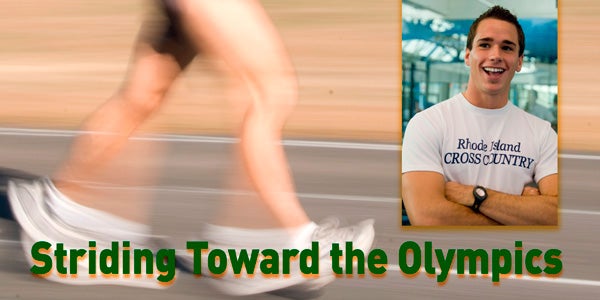Striding Toward the Olympics

Mike Kazmierczak turns heads wherever he goes. People even imitate him.
The junior political science and sociology major is a race walker. He’s not just any run-of-the-track race walker. In fact, it’s not hyperbole to say Kazmierczak is one of the best in the world. He is striding toward the Olympics, which will be held in Beijing, China, in August.
Never heard of racewalking? It’s been an Olympic event for more than a century. It’s sometimes confused with speedwalking because racers “walk” at a fast pace. But the similarity ends there. Speedwalking, like power walking, doesn’t have rules, judges, or gold medals. Race walking has all three.
Race walking is about endurance. There are two Olympic events: a 50K (31 miles) race and a 20K (12.4 mile) race.
Kazmierczak planned to race in both Olympics trials. A fall on ice and the resulting injury last December knocked him out of the 50K trials held in February. Not one to be deterred, he picked himself up, brushed himself off, and is ready to compete in 20K trials in July. If successful, he will be one of the three-member team representing the United States at the Olympics.
If you watch the 20-year-old student practice on the Mackal Field House track, you might think that he has a stone in his shoe or a bad callous. His “walk” is purposeful, following the stringent rules of the sport:
One foot must be on the ground at all times, The lead leg must be kept straight.
When Kazmierczak races his shoulders are held straight and his hands are held low, close to his hips. He appears to have a bit of swivel caused by the heal-to-toe action necessitated by the rules.
Since judges must watch the racers’ form at all times, races are always held on a looped track. Watching for a bent knee or lifted foot isn’t an easy task since racewalkers like Kazmierczak can “walk” a mile under 6 minutes. Sometimes a violation can only be captured by high-speed film. The judges can, and do, issue violations. Like baseball, three of them mean the racewalker is out of the race.
How Kazmierczak became a race walker can either be chalked up to timing or destiny or a combination of both. Arriving late at the Empire State Games in New York when he was a high school sophomore, the Long Islander decided to enter the last track event—race walking—even though he had never tried it. He placed third, actually winning the race because the other two competitors in front of him were disqualified.
He became a member of the U.S. National Racewalking Team the following year. “I prefer running, but I’m better at walking,” he says.
He hadn’t planned to attend URI, but another twist of fate brought him to Kingston. He was offered a full scholarship at Drake University, but when he arrived there, he was told the scholarship was withdrawn due to budgetary reasons. He applied to 23 other schools, but it was URI’s Head Track Coach John Copeland who convinced the Long Islander that the University was the place to chase his dreams.
As a member of the URI track team, Kazmierczak cross trains with the cross country team. “My teammates have been supportive of me,” he says appreciatively. “They come to races to cheer me on.”
During his freshman year, he was named the 2006 USA Track and Field Junior Athlete of the Year; he won a silver medal at the USA vs Canada Dual Match, competed at the World Cup in La Coruna, Spain, and was awarded six All-American honors. During his sophomore year, he won a silver medal at the Under 23 North American, Central American, Caribbean Cup (the NACAC Cup), qualified for the Olympic Trials, and earned six All-American Honors.
This year, the honor student is studying, practicing, and racing in Europe and around the U.S. This May he is competing in the World Cup in Russia.
What does it take to be a racewalker? “You have to be mentally fit,” says the athlete, who trains 10 to 15 miles a day every day, “self-motivated, and independent.”
When the going gets tough, Kazmierczak admits he gets going. “I talk to myself when I’m racing, reminding myself that I’ve worked too hard to let go.”
Kazmierczak plans to become a medical malpractice lawyer. In the meantime, he’s studying and practicing every day.
If he doesn’t make the Olympic team this time around, there will be other chances to compete and other trophies and medals to win.
By Jan Wenzel ’87
Photos By Nora Lewis
 Home
Home Browse
Browse Close
Close Events
Events Maps
Maps Email
Email Brightspace
Brightspace eCampus
eCampus


